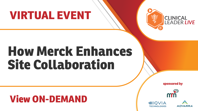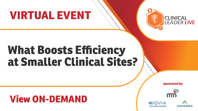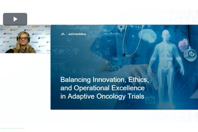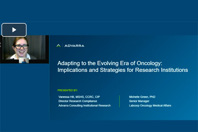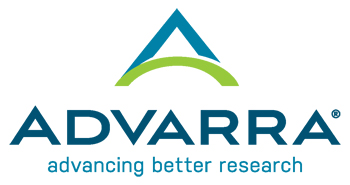
ABOUT ADVARRA
Advarra advances the way clinical research is conducted: bringing life sciences companies, CROs, research sites, investigators, and academia together at the intersection of safety, technology, and collaboration. With trusted IRB and IBC review solutions, innovative technologies, experienced consultants, and deep-seated connections across the industry, Advarra provides integrated solutions that safeguard trial participants, empower clinical sites, ensure compliance, and optimize research performance. Advarra is advancing clinical trials to make them safer, smarter, and faster. For more information, visit advarra.com.
FEATURED ARTICLES
-
This survey explores how the complexity of clinical research has increasingly challenged the dynamics among research sites, sponsors, and contract research organizations (CROs).
-
Get an overview of the essential components involved in providing independent statistical center support for a data safety monitoring board (DSMB), also known as a data monitoring committee (DMC).
-
Explore key differences in regulatory requirements for medical device studies compared to drug trials, and learn why understanding the unique term UADE is crucial for compliance and safety.
-
By following this checklist, research teams can enhance organizational efficiency, maintain compliance with regulatory standards, and confidently navigate the complexities of documentation management.
-
Explore the practical implications faced by investigators and their support staff, such as navigating new bureaucratic procedures and adhering to revised regulatory requirements.
-
How can effective hazard communication and SOPs from institutional biosafety committees enhance safety in clinical trials involving rDNA technologies and genetically modified biological agents?
-
This step-by-step guide helps sponsors and sites prepare for and navigate the various types of audits required at each stage of the clinical trial process.
-
Delve into the importance of training and educating research staff on the sIRB process, fostering a culture of collaboration, and developing mechanisms for monitoring compliance and managing conflicts.
-
What role does Good Clinical Practice (GCP) play in the clinical research ecosystem and how does it safeguard participant rights, safety, and confidentiality while fostering compliance?
-
This overview highlights real research programs at various stages of the recruitment process and demonstrates the impact of Advarra’s Longboat Platform across multiple therapeutic areas and sponsors.
-
Learn why understanding the intricacies of IRB review for study changes is essential for researchers and institutions, covering everything from minor amendments to significant modifications.
-
Learn how a CRO was able to accelerate review times so COVID-19 vaccine trial sites could progress through site selection, IRB/IBC submission, approval, drug shipment, and complete site initiation visits in record time.
-
By bringing objective evaluation, expertise, and effective change management skills, learn how interim staff can improve an institution’s ability to identify issues and implement necessary changes.
-
With technology advancing clinical operations, proactive adaptation is paramount for organizations to remain at the forefront. How can your organization effectively navigate these evolving dynamics?
VIDEOS
-
Karri Venn of SCRS discussed the value of deep partnerships, referencing a Sanofi initiative (SMILE) that trusted sites with protocol input and offered maximum budgets without negotiation.
-
Adam Kinsey described how sponsor-site partnerships at Merck typically start small. Sites are evaluated not only on enrollment but on predictability and communication throughout a study.
-
Site owner Devora Henderson of Elevate Clinical Research reflected on her experience launching two site networks.
-
Learn about Merck’s approach to fostering strong site relationships through specialty roles like institutional lead CRAs and site relationship managers.
-
Devora Henderson, CEO of Elevate Clinical Research, highlighted the need for clear points of contact at smaller sites.
-
Karri Venn, VP site advocacy and mentorship at SCRS, emphasized the importance of sponsors recognizing the structure and capabilities of larger site networks.
-
Experts discuss how to navigate the complexities of adaptive trial designs and how ethics reviews uphold patient safety, ensure informed consent, and provide robust oversight.
-
As biomarker-directed therapies drive advancements in the oncology space, experts are reviewing cutting-edge trends and strategies that help institutions address ethical and regulatory challenges.
-
Watch to learn the reasons why research sites, site networks, health systems, academic medical centers, and cancer centers use a CTMS to centralize information related to protocols, subjects, staff, financials and billing, and much more.
CONTACT INFORMATION
Advarra
6940 Columbia Gateway Drive, Suite 110
Columbia, MD 21046
UNITED STATES
Phone: 410.884.2900


















